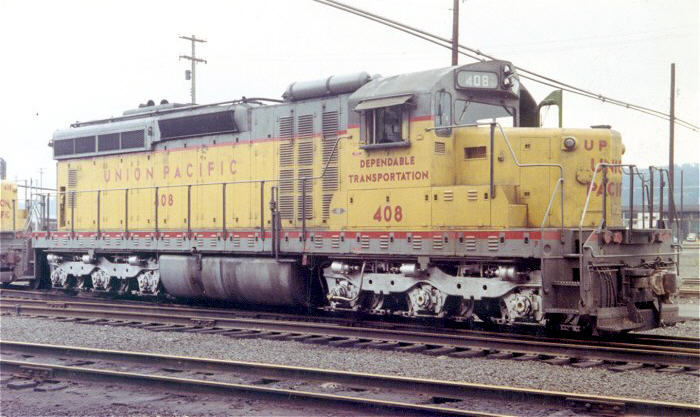- EMD SD24
Infobox Locomotive
name=EMD SD24
powertype=Diesel-electric
gauge=RailGauge|ussg

caption=UP #408 at the company'sPortland, Oregon , Albina Yard in July,1968 . The unit's roof-mounted "torpedo tube" air reservoirs, a signature feature, are clearly visible just aft of the locomotive's cab.
poweroutput=2,400 hp (1,800 kW)
aarwheels=C-C
builder=General Motors Electro-Motive Division (EMD)
buildmodel=SD24
builddate=July1958 – March1963
totalproduction=179A unit s, 45B unit s
The EMD SD24 was a 2,400 hp (1,800 kW) C-Cdiesel locomotive built by General Motors' Electro-Motive Division ofLa Grange, Illinois between July,1958 and March,1963 . [pinkepank diesel spotters guide 2] A total of 224 units were built for customers in theUnited States , comprising 179 regular, cab-equipped locomotives and 45 cablessB unit s. The latter were built solely for theUnion Pacific Railroad .cite journal
author = "Diesel Era" staff
title = EMD's SD24
journal = Diesel Era
volume = 9
issue = 3
pages = 10–29, 51–63]The SD24 was the first EMD locomotive to be built with an EMD turbocharged diesel engine, sixteen months before the four-axle (B-B) model GP20. Power output was substantially higher than the 1,800 hp (1,350 kW) of the concurrent
Roots blower -equipped SD18s with the sameengine displacement .In terms of sales, the SD24 was only a moderate success, and few had long service lives in SD24 configuration (though many rebuilds are still in operation), but the SD24 was a milestone in EMD locomotive development and the forerunner to today's high-powered six-axle locomotives.
Options
Optional equipment that could be specified by ordering railroads included
multiple unit controls, asteam generator ,dynamic brakes , winterization equipment, an air signal line, and hump control, but actually almost all delivered SD24s were very similar in configuration.The standard fuel tank offered a 1,200 US gallon capacity, while 2,400 or 3,000 US gallon tanks were optional. In practice, all SD24s ordered had the 3,000 gallon tank except for the last built,
Kennecott Copper 's single locomotive. In order to provide room for a larger fuel tank, the air reservoirs were relocated on the roof just behind the locomotive's cab. The tanks were known as "torpedo tubes" due to their long, thin design. Factory-installation of these tanks was peculiar to this model locomotive.Winterization included a winterization hatch over one of the fans.
Either a low or high
short hood could be ordered; in either case, the short hood was front by default. The Burlington, Southern and first EMD demonstrator had high short hoods; all others were low. Low short hoods from the factory had a pronounced downward slope of the top towards the nose, as did those of the contemporary GP20. Many of the high short hood units had their noses chopped later on, often as a consequence of rebuilding; these as a rule have flat-topped short hoods.Rebuilds
As the SD24 locomotives aged, they began to develop reliability problems, especially electrical ones. In addition, the extra maintenance requirements of the turbocharged engine were acceptable when they were some of the most powerful locomotives available, but in secondary service, they were an expensive way to get 2,400 hp. Thus, a large number of SD24s were rebuilt by various owners to extend their lives.
Santa Fe SD26
From January, 1973 through January, 1978 the
Atchison, Topeka and Santa Fe Railway rebuilt its fleet of eighty SD24 locomotives, naming the resulting type theSD26 . The rebuild boosted the power output of the locomotives by replacing the 16-567D3 engines with 16-645E3 models. Other work improved the reliability by replacing the entire electrical systems, and replacing the multiple body-side vents with a central air filtration system. The large box fitted high on the body behind the cab for the air filters required relocating the "torpedo tube" air reservoirs further back on the long hood, and gave the SD26 a noticeable "hump-backed" appearance.Union Pacific SD24m
The
Union Pacific Railroad modified three SD24 locomotives experimentally to see if it would be worthwhile to upgrade their fleet of 30 such locomotives.cite web
url = http://utahrails.net/articles/up-sd24.php
author = Strack, Dan
title = Union Pacific EMD SD24s
work = Utah Rails
accessdate = 2006-11-27]Unit 410 received the most minor modification: upgraded air filters.cite web
url = http://utahrails.net/all-time/all-time-05.php
title = All-Time UP Diesel Roster, Part 5
author = Strack, Dan
work = Utah Rails
accessdate = 2006-11-27]UP 423, however, was substantially rebuilt to UP 3100 in August 1968 with a constant-speed 16-645 3,000 hp (2,240 kW) prime mover, a new alternator and new traction motors. With the constant-speed engine, speed control was via changing the level of
excitation of the alternator; the traction motors were permanently wired in parallel. New, variabledynamic brake s were also fitted, as was a self load feature enabling testing under load without an external electrical load apparatus. This latter feature became standard on later locomotive models. The constant-speed prime mover, on the other hand, was not successful enough to duplicate. The locomotive was from 1975 used as a heavyswitcher at UP'sNorth Platte, Nebraska hump yard s, a fate common to UP's other surviving SD24s.UP 414 did not receive as major a modification as #423, but it was refitted with a 16-645 engine, AR10 alternator and Dash Two electrical cabinet in May 1974, making it effectively a
EMD SD40-2 . This was a testbed for a proposed upgrade of all UP's SD24s, but UP decided not to go ahead with the work. Both UP 3100 and UP 414 were classified as "SD24m" by the UP, but some UP internal documents class UP 414 as a "SD24-4".Original purchasers
References
External links
* [http://www.irm.org/dieseldept/technicaldata/EMD/SD24/gm-sd24diagram.jpgEMD SD24 Diagram] at the [http://www.irm.org/ Illinois Railway Museum] official website.
Wikimedia Foundation. 2010.
